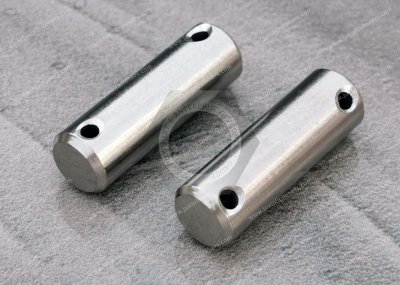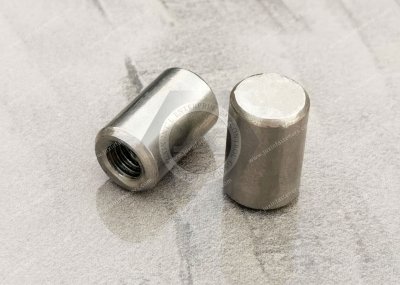Call Us
+86 136 6007 9809
Call Us
+86 136 6007 9809
Nov. 04, 2023
Mechanical processing is one of the main methods of dowel pin processing. Small-size dowel pins generally use the corresponding specifications of the wire directly cold upsetting molding, and slightly larger dowel pins use the turning + grinding process. Pins are generally used for coupling, locking parts, or assembly positioning and can also be used as parts of safety devices. Dowel pins are fixed in the hole by interference and used to improve the parts, transfer power, or position parts. Dowel pins are locating pins used to improve the relative position between parts. It is an essential auxiliary part in combination processing and assembly. Ordinary dowel pins are produced by forging, drawing, or sheet metal molding. Then, after turning, grinding, and surface treatment processes, they are used to make the final dowel pin products. Compared with other parts, the process requirements of ordinary dowel pins are relatively low, with a short production cycle, low cost, and other advantages.
Dowel pin characteristics:The pinhole should be reamed, using a small amount of interference to fix the cylindrical pin in the pinhole. Multiple disassemblies will decrease the amount of interference, reducing the connection's firmness and positioning accuracy. It can be used for positioning, coupling, and safety pins.
Dowel pin tolerance control is essential to ensure the accuracy and quality of parts. We understand the tolerance knowledge of dowel pins from the tolerance zone, tolerance level, upper and lower limit tolerances, and so on. Scope of application: They are used for positioning and coupling but can also be used as safety pins.
Characteristics of female dowel pins: The female thread of female dowel pins is used for disassembly, and the positioning accuracy of threaded dowel pins is low, so they are suitable for occasions with low precision requirements.
The tolerance of the diameter of female threaded pins is m6. There are two types of female threaded pins: A and B. The B type has a ventilating plane.
Dowel pin types and specifications:There are several types of dowel pins, such as ordinary dowel pins, internally threaded dowel pins, threaded cylindrical pins, pins with holes, and elastic dowel pins.
Ordinary dowel pins, internally threaded dowel pins, and elastic dowel pins.
Characteristics of ordinary dowel pins: The pinhole should be reamed. Fixing the dowel pin in the pinhole many times and disassembling it with a small amount of interference with a small amount of interference will decrease the amount of interference, reducing the firmness of the connection and positioning accuracy.
Application scope: Used for positioning and coupling, but can also be used as a safety pin. Dowel pins, taper pins with internal thread, dowel pins, dowel pins with internal thread, taper pins with open end, threaded dowel pins, elastic dowel pins, straight groove, lightweight, pins with holes, taper pins with screw end, cotter pins, and so on. The primary forms of pins are dowel pins and taper pins. Dowel pins are fixed in the pinhole using trace interference. Multiple mounting and dismounting reduces positioning accuracy. Dowel pins have a taper of 1:50, can be self-locked, set in the pinhole by taper extrusion, have high positioning accuracy, are easy to install, and can be mounted and dismounted many times.
Characteristics of internally threaded dowel pins: the pinhole should be reamed, the use of a small amount of interference to fix the dowel pin in the pinhole many times dismounting will make the amount of interference decrease, reducing the firmness of the connection and positioning accuracy. Application scope: Used for positioning and coupling, but can also be used as a safety pin. The inner threaded cylindrical pin is used for blind holes.
Characteristics of elastic dowel pin: made of spring steel with longitudinal slit and quenched round tube. It is solid and reliable, utilizing its high elasticity, uniformly squeezed in the pinhole.
The precision and surface roughness of the pinhole require less and can be installed and disassembled many times, but the stiffness is poor.
Application scope: suitable for occasions with shock and vibration. It is not ideal for positioning with high precision requirements.
Ordinary dowel pins are available in various specifications, both standard and non-standard sizes; the typical specifications are 5-20mm in diameter and 20-100mm in length. More refined specifications can be customized according to different usage scenarios and needs.


What are the materials of dowel pins?
The standard material of the pin is 35 or 45 steel. The material of the safety pin is 35, 45, 50, T8A, T10A, etc., and the hardness is 30~36 HRC after heat treatment. The material of the pin sleeve can be used 45, 35SiMn, 40Cr, etc., and the hardness is 40~50 HRC after heat treatment. Dowel pins are mostly made of high-quality carbon structural steel as raw material. Generally, the material is mainly C35 and C45 but must be heat-treated—high-strength requirements under bearing steel. Elastic dowel pins are mostly made of 65Mn. Stainless steel materials have good corrosion resistance and can be preferred to 304, 316, 410, and other materials when there are corrosive conditions in the use environment. Dowel pins are generally oiled for color treatment; special requirements can also be used for oxidation blackening, phosphating, and non-electrolytic zinc flake coating, which can effectively increase the corrosion resistance of dowel pins and enhance the service life. It can also be assembled and coated with anti-rust oil; it has a specific viscosity or weighing degree and is attached to the metal surface to form a hard or soft continuous film so that the air and water isolation prevents rust of steel or non-ferrous metals. Ordinary dowel pins are generally made of carbon structural steel or alloy structural steel materials; some high-demand occasions also need to use stainless steel or copper and other materials.
Nature of interference fit:The interference fit is divided into two types: direct interference and interference with auxiliary parts. The former is realized using the two parts' interference fit, relying on friction to transfer the load. The interference fit of the dowel pin belongs to the direct interference fit. Installation of a dowel pin hole generally needs a dumpling system installation in the dowel pin is coated with a small amount of lubricating oil, with a copper rod pad in the pin end face; the pin will be punched into the hole or with a C-shaped clip to press the pin into the hole.
The Nature and application of dowel pin:A Dowel pin is a commonly used connecting part that can quickly disassemble, transfer power, bear shear force, and other characteristics. Its structure is a cylinder, and the common materials are steel, copper, aluminum, etc.
Dowel pins have two types of connections: axial cartridge and notch type, which can be widely used in mechanical equipment, automobiles, furniture, and other fields.
Simple structure, good alignment, high load carrying capacity, good performance of variable load and impact, but requires high machining accuracy of the mating surface. The dismantling force is large, which will bruise the mating surface, and it belongs to a non-disassembled connection. There is not much interference or hydraulic mounting and dismounting; the coupling is also removable, and the type of pin used is according to the requirements of its work selection. In connection with the pin, its diameter can be based on the structural characteristics of the connection, determined by experience, and then the strength check, if necessary. The directness of the locating pin can be determined according to the structure. The length of the pin in each connection is about 1~2 times its diameter—wide application. Ordinary dowel pins are widely used in various industries, such as machine tools, automobiles, ships, electrical equipment, etc. They are mainly used for connecting and fixing mechanical parts and components and are characterized by compact structure and easy installation.
Dowel pin selection criteria
1. Selection according to the requirements of the connecting parts
The dowel pin is one of the connecting parts used on different occasions, but the requirements are additional. To carry out high-speed rotation, you must choose high-precision dowel pins; in a demanding environment, you should choose better corrosion-resistant materials.
2. Selection according to the processing technology of the connectors
Dowel pin processing technology generally includes heat treatment, cold working, grinding, etc. In the selection, we should also consider the processing technology factors to ensure that the quality of the dowel pin meets the requirements.
3. Selection according to the installation mode of the connecting parts
Dowel pin connection includes axial cartridge and groove type two; the selection should also be selected according to the actual situation to ensure the stability and reliability of the connection.
If you are looking for high-quality automotive fastener screws & all kinds of plastic fasteners or technical support for structural design, please get in touch with me. Use our new Product Finder tool, download our Product Catalog, and let us help you get custom parts.adelajonly@gmail.com. Thanks. Website: www.juxinfasteners.com
Contact Us
Tel.:
+86 020 8621 0320
+86 020 3121 6067
Technical Support:
Navigation
SEND INQUIREY